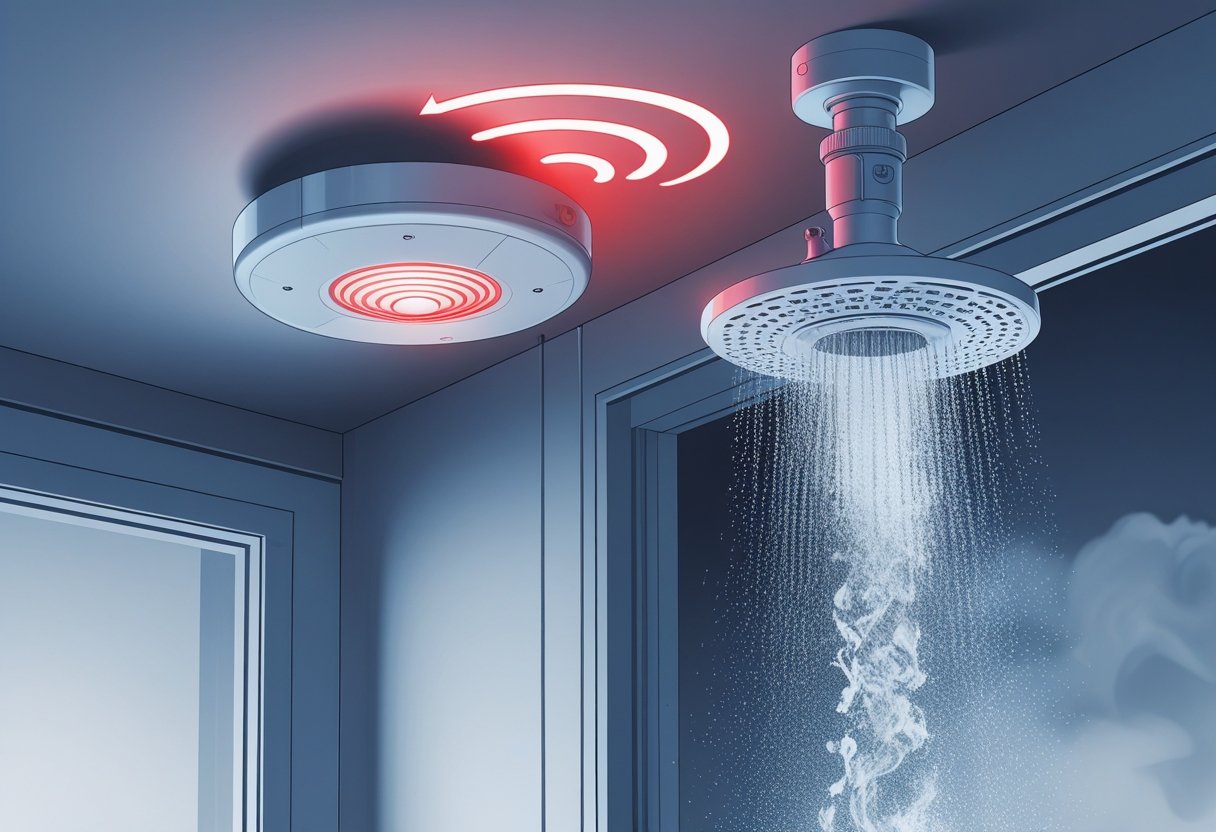When it comes to fire safety, understanding the interplay between fire alarms and sprinklers is crucial for protecting your property and loved ones. These systems are designed to work in tandem, ensuring timely alerts and effective suppression during a fire emergency. Fire alarms detect smoke and heat, automatically activating sprinkler systems to control or extinguish flames, significantly enhancing your safety strategy.
The integration of these systems involves a series of interconnected components that communicate seamlessly. When a fire alarm sensor activates, it sends a signal not only to alert occupants but also to trigger the sprinklers, initiating a coordinated response. This combination offers a comprehensive approach to fire protection that maximizes efficiency and minimizes damage.
In the greater Houston area, having a reliable fire alarm and sprinkler system can be the difference between a minor incident and a catastrophic event. Understanding how these systems collaborate will empower you to make informed decisions about your fire safety solutions.
How Fire Alarms and Sprinkler Systems Work Together
Fire alarms and sprinkler systems are crucial components of a comprehensive fire protection strategy. They work in tandem to ensure rapid detection and response to fires, enhancing occupant safety and minimizing property damage.
Integrated Detection and Response
The integration of fire alarm systems with sprinkler systems creates a seamless approach to fire prevention. When a fire alarm detects smoke or heat, it triggers a series of actions. This often includes activating the sprinkler system.
Sprinkler heads are designed to respond to heat. When the temperature rises to a predetermined level, they release water in the affected area. This immediate response helps to control or even extinguish the fire before it spreads further.
Real-time monitoring capabilities allow these integrated systems to adjust their response based on evolving fire conditions. By working together, fire alarms and sprinklers enhance the effectiveness of fire safety measures within your property.
Communication Between Systems
Effective communication between fire alarms and sprinkler systems is vital for optimal performance. Both systems typically connect through a shared control panel, allowing them to send and receive signals.
Devices such as water flow and tamper switches play key roles in this communication. When a sprinkler activates, it sends a signal to the fire alarm, notifying both the occupants and emergency responders. Conversely, if the fire alarm detects an issue, it can prompt the sprinkler system to activate.
This interaction minimizes confusion during an emergency and helps ensure a coordinated response. You can rest easier knowing that your fire protection systems are working together efficiently.
Enhancing Fire Safety Outcomes
Integrating fire alarm systems with sprinkler systems significantly improves fire safety outcomes in any building. This collaboration not only provides real-time alerts but also increases the chances of early fire suppression.
The combination of early detection and effective suppression measures is essential for protecting lives and property. As fires can escalate quickly, having both systems in place allows for a rapid and coordinated action plan.
In the greater Houston area, focusing on both fire alarms and sprinklers can offer peace of mind and greater safety. Your buildings will be better equipped to respond effectively to fire incidents, enhancing the overall fire protection strategy.
Core Functions of Fire Alarms and Sprinklers
Fire alarms and sprinkler systems work together to provide comprehensive fire safety in buildings. Their core functions include early detection of fires, activation of fire suppression measures, and notification of occupants for safe evacuation.
Role of Early Detection
Early detection is crucial in minimizing fire damage and enhancing safety. Fire alarm systems utilize various sensors, such as smoke detectors and heat detectors, to identify fires at their initial stages.
Smoke detectors are sensitive to airborne particles produced during combustion, while heat detectors activate when a specific temperature threshold is breached.
When these sensors detect a fire, they immediately signal the central control panel, initiating a series of safety protocols. This rapid response is essential to ensuring that occupants receive ample warning and time to evacuate safely.
Sprinkler Activation and Suppression
The integration of sprinkler systems enhances fire suppression efforts. Sprinklers operate automatically when a fire is detected, primarily through sprinkler heads that release water in response to heat.
Once a fire alarm is triggered, the system activates specific sprinkler heads in the affected area. This localized response helps to contain or extinguish the fire before it spreads further.
The combination of early detection and immediate sprinkler activation is an effective strategy for minimizing damage and protecting lives. In many cases, sprinkler systems can significantly reduce the intensity of a fire while fire services are on the way.
Notification and Evacuation
A critical function of fire alarm systems is to notify occupants of a fire emergency. Once a fire is detected, the system emits a loud alarm and can also activate visual alerts, ensuring everyone is aware of the situation.
Effective notifications are essential for timely evacuations. Many modern systems allow for clear instructions, guiding occupants to the safest exits based on the fire's location.
In commercial and residential buildings within the greater Houston area, having an integrated fire alarm and sprinkler system not only aligns with safety regulations but also enhances the overall safety of your environment, protecting both people and property.
System Integration and Coordination
Effective integration between fire alarms and sprinkler systems enhances safety by ensuring rapid response during emergencies. Proper coordination facilitates communication between these systems, optimizing their effectiveness and supporting emergency responders.
Fire Alarm Control Unit Operations
The fire alarm control unit (FACU) is central to the coordination of fire safety systems. It monitors inputs from various devices, including smoke detectors and manual pull stations. Upon detecting an issue, the FACU triggers the alarm signals, notifying building occupants and activating the sprinklers.
This unit also sends notifications to emergency responders, such as the fire department. In addition, it manages alarm silencing, ensures proper system operation, and initiates pre-programmed safety protocols tailored to your specific building needs. Regular testing and maintenance of the FACU guarantee optimal performance during a fire emergency.
Water Flow and Tamper Switches
Water flow and tamper switches play crucial roles in the integration of fire alarms and sprinklers. When a sprinkler head activates, the water flow switch senses the flow of water and signals the fire alarm system to alert occupants. This immediate communication is essential for efficient evacuation.
Tamper switches monitor the integrity of the sprinkler system. If a valve is closed or tampered with, the system will notify the FACU. This real-time information enables timely responses, preventing potential delays in system activation. Understanding these components ensures you maintain a reliable and effective fire safety network in your building.
Coordination with Emergency Responders
Effective communication with emergency responders is vital for a successful fire safety strategy. The fire alarm control unit provides real-time information about the building's status to the fire department upon arrival. This data includes the location of the fire, the activation of sprinklers, and any other relevant alarms.
Additionally, having a well-integrated system allows responders to focus on controlling the fire rather than assessing the situation. Ensuring that your building's systems are compliant and well-maintained can significantly enhance the efficiency of emergency responders when they arrive at your location in Houston.
Design, Regulations, and Compliance
Understanding the interplay between design, regulations, and compliance is essential for effective fire alarm and sprinkler systems. These elements ensure that your systems function optimally, meet legal standards, and provide necessary safety measures in various environments.
Building Codes and Legal Requirements
Building codes dictate the design and installation of fire alarm and sprinkler systems. You must ensure that your systems comply with local regulations, which often align with standards set by organizations like the National Fire Protection Association (NFPA). In the greater Houston area, compliance with specific local codes can be critical.
The codes outline the necessary features of fire alarm systems, such as detector placement and response times, as well as sprinkler system requirements, including appropriate coverage areas. Failure to adhere to these codes can result in legal repercussions and increased liability.
Inspection and Maintenance Standards
Regular inspection and maintenance of your fire alarm and sprinkler systems are crucial for compliance and functionality. Local regulations often mandate that systems are inspected at specific intervals, typically annually or semi-annually, to ensure they operate effectively.
Maintenance protocols include checking alarm signals, testing sprinkler heads, and ensuring that control panels function as intended. Engaging qualified professionals for these tasks not only maintains compliance but also enhances overall safety in your building.
Coverage in Diverse Environments
Different environments present unique challenges for fire alarm and sprinkler system design. For instance, residential properties may require different considerations compared to commercial buildings. In high-risk areas like kitchens or warehouses, you must ensure enhanced detection and suppression capabilities.
Diverse building types may necessitate varying system designs, including specific zoning and interconnectivity between fire alarms and sprinklers. Local codes can guide these adaptations to ensure optimal coverage and compliance while providing the highest level of safety for occupants.
Benefits and Limitations of System Integration
Integrating fire alarms and sprinkler systems offers essential advantages for fire protection and safety, but also presents certain limitations. Understanding these aspects can help you make informed decisions about system design and implementation.
Redundancy and Reliability
One of the primary benefits of integrating these systems is enhanced redundancy. This means that if one component fails, the other can still function, providing a backup layer of fire safety. For example, if sprinklers malfunction, the fire alarm can still alert occupants and emergency responders.
Furthermore, combined systems increase reliability. A sprinkler system that activates simultaneously with an alarm can better manage fires, reducing the potential for damage. The interconnected nature of these systems ensures that both components work together seamlessly, improving the overall effectiveness of your fire prevention strategy.
Reducing Damage and Ensuring Safety
The integration of alarms and sprinklers significantly reduces damage during a fire event. When both systems work in tandem, they provide a quick and coordinated response, which limits the flames' spread.
For instance, when a fire alarm detects smoke, it can trigger the sprinkler system to activate immediately, suppressing the fire at its source. This rapid response not only protects your property but also ensures the safety of building occupants. By employing this integrated approach, you gain a powerful tool in your fire protection arsenal.
Continuous Monitoring and Adaptability
Integrated fire systems offer continuous monitoring capabilities, delivering real-time updates on fire status. This feature allows you to react swiftly to evolving situations.
Advanced control panels can adjust the operation of sprinklers based on the fire's development, showcasing adaptability. If a fire spreads, the system can modify its suppression strategy accordingly. This dynamic interaction maximizes both safety and effectiveness in fire response situations, providing peace of mind for you and your building's occupants.
Frequently Asked Questions
Understanding the interaction between fire alarms and sprinkler systems is crucial for effective fire safety management. The following points address common inquiries regarding their operation, legal requirements, and roles in enhancing safety.
What is the function of fire alarms in conjunction with sprinkler systems?
Fire alarms detect smoke and heat, providing early warnings during a fire. When triggered, they can signal the sprinkler system to activate, ensuring that water is deployed to control the blaze quickly. This coordinated response is vital for minimizing damage and protecting occupants.
What are the legal requirements for integrating fire alarms and sprinkler systems in residential buildings?
In the greater Houston area, local building codes often mandate that residential buildings have integrated fire alarm and sprinkler systems. These requirements ensure that life safety measures work together seamlessly, enhancing fire prevention and emergency response.
How do smoke detectors interact with sprinkler systems during a fire?
When smoke detectors sense a fire, they activate the fire alarm system. This alarm can trigger the sprinkler system, allowing it to deploy water to control or extinguish the fire. This interaction significantly improves response time and effectiveness in fire scenarios.
What role do control valves play in the operation of fire alarms and sprinkler systems?
Control valves are critical components that regulate water flow in sprinkler systems. They must work in tandem with fire alarms, allowing water to be directed to the appropriate areas when an alarm is activated. Properly maintained valves ensure that the system functions effectively during an emergency.
How does the integration of sprinkler systems and fire alarms enhance safety in buildings?
Integrating these systems creates a comprehensive fire safety strategy. This combination maximizes the chances of early fire suppression and limits the fire's spread, significantly improving occupant safety and reducing potential property loss.
In what ways do residential sprinkler systems and smoke alarms work together to prevent fatalities in case of fire?
In a residential setting, smoke alarms detect heat and smoke, activating the alarm and automatically triggering the sprinkler system. This synergy helps control the fire, providing residents with more time to evacuate safely, ultimately reducing the risk of fatalities.
.svg)



.svg)


.svg)



